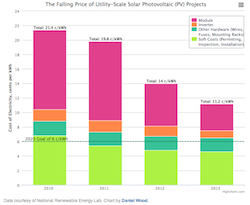The U.S. solar industry is more than 60 percent of the way to achieving cost-competitive utility-scale solar photovoltaic (PV) electricity – only three years into the Department’s decade-long SunShot Initiative, reports the U.S. Department of Energy (DOE). To help continue this progress, the DOE announced $25 million in new funding to strengthen U.S. solar manufacturing for photovoltaic and concentrating solar power (CSP) technologies and to maintain a strong domestic solar industry – supporting the Department’s broader Clean Energy Manufacturing Initiative.
 The U.S. is playing a growing role as a global leader in solar as demonstrated in a new industry report which recently found that U.S. utility-scale solar set a record with 2.3 gigawatts installed in 2013. As a direct result of increased solar generation, over the last three years, the cost of a solar energy system has dropped by more than 50 percent, helping to give more and more American families and businesses access to affordable, clean energy.
The U.S. is playing a growing role as a global leader in solar as demonstrated in a new industry report which recently found that U.S. utility-scale solar set a record with 2.3 gigawatts installed in 2013. As a direct result of increased solar generation, over the last three years, the cost of a solar energy system has dropped by more than 50 percent, helping to give more and more American families and businesses access to affordable, clean energy.
“In just the last few years, the U.S. has seen remarkable increases in clean and renewable energy – doubling the amount of energy that we produce from solar and wind and supporting a strong, competitive solar supply chain that employs American workers in every state,” said Energy Secretary Moniz. “To continue this growth and position the U.S. as a global leader in clean energy innovation, the Energy Department is helping to advance new technologies that further reduce costs, improve performance and support new jobs and businesses across the country.”
In 2011, DOE launched its SunShot Initiative to make solar energy cost-competitive with traditional energy sources by the end of the decade. As a result of the program, today, the utility-scale PV industry is more than 60 percent of the way to achieving SunShot’s target of $0.06 per kilowatt-hour. In the United States, the average price for a utility-scale PV project has dropped from about $0.21 per kilowatt-hour in 2010 to $0.11 per kilowatt-hour at the end of 2013. According to the Energy Information Administration, the average U.S. electricity price is about $0.12 per kilowatt-hour.
Reductions in the cost of electricity are based on estimates of the levelized cost of electricity (LCOE). The LCOE is a measure of the national average of electricity cost based on certain assumptions regarding financing costs and generation availability projected over the life of a generating asset. The LCOE model provides a benchmark for measuring relative changes in electricity costs.

